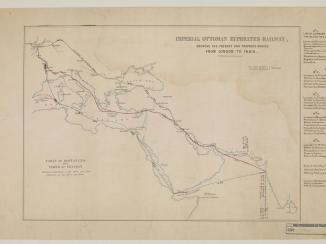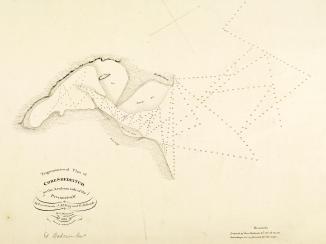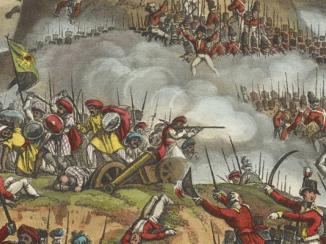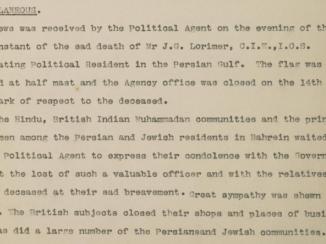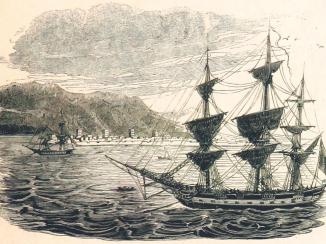Coll 7/14 'Persia and Persian Gulf: suggested Anglo-Persian Arms Traffic Agreement. Persia and the Arms Traffic Convention'
IOR/L/PS/12/2182
1,190 items in this record
Search within this record
The record is made up of 1 volume (591 folios). It was created in 18 Aug 1926-28 Jun 1933. It was written in English and French. The original is part of the British Library: India Office The department of the British Government to which the Government of India reported between 1858 and 1947. The successor to the Court of Directors. Records and Private Papers Documents collected in a private capacity. .
About this record
- Content
The volume consists of extensive correspondence, plus minutes and memoranda, relating to the 1925 Convention for the Supervision of the International Trade in Arms and Ammunition and in Implements of War (Arms Traffic Convention), and the subsequent attempts to reproduce certain of its provisions in an international covenant at the Geneva Disarmament Conference of 1932-1933.
The principal correspondents are: the Government of India Foreign and Political Department; the India Office The department of the British Government to which the Government of India reported between 1858 and 1947. The successor to the Court of Directors. Political Department; the Admiralty; the Foreign Office; HM Minister at Tehran (R H Hoare); the Political Resident A senior ranking political representative (equivalent to a Consul General) from the diplomatic corps of the Government of India or one of its subordinate provincial governments, in charge of a Political Residency. in the Persian Gulf The historical term used to describe the body of water between the Arabian Peninsula and Iran. ; and the UK Delegate to the Disarmament Conference (E H Carr). The volume also contains a number of communications received from members of the Persian Government (Muhammad Ali Foroughi [Furūghī], Abdolhossein Teymourtache, and Anoushirvan Khan Sepahbodi).
The material principally concerns negotiations between the Persian [Iranian] and British Governments. The Persian Government wished to have the Persian Gulf The historical term used to describe the body of water between the Arabian Peninsula and Iran. and the Gulf of Oman excluded from the list of special maritime zones, and sought British support in achieving this at the Conference. In response to British concerns about the possible impact on their ability to effectively limit the transport of arms and slaves in the region, the Persian Government proposed a bilateral Anglo-Persian treaty.
The following topics are discussed in depth:
- general Anglo-Persian relations, and the British desire to make progress with regards to the position of Henjam;
- the traffic in arms and slaves in the Persian Gulf The historical term used to describe the body of water between the Arabian Peninsula and Iran. , the Gulf of Oman, and the Red Sea;
- the reluctance of several nations to ratify the 1925 Arms Traffic Convention;
- the definition and designation of 'special zones', 'special maritime zones' and 'native vessels' within the proposed conventions;
- the proposed bilateral treaty, its terms and conditions;
- the rights to inspect foreign vessels in the Persian Gulf The historical term used to describe the body of water between the Arabian Peninsula and Iran. , and British concerns over the ability of Persia to inspect British, Indian and Gulf vessels;
- the possibility of enabling other nations to accede to the bilateral treaty separately, to enable British inspection of the vessels of other nations within the Persian Gulf The historical term used to describe the body of water between the Arabian Peninsula and Iran. ;
- and the concerns of the Admiralty over the potential impact that the agreement would have on their ability to police the traffic in arms and slaves.
The following are particular items of interest:
- memorandum of the Persian Delegation to the League of Nations, noting their objections to the Arms Traffic Convention, ff 517-522;
- communication from HM Legation to Tehran, enclosing details of an interview with the Persian Minister for Foreign Affairs and Minister for the Court (Foroughi and Teymourtache), ff 492-500;
- minutes of the Interdepartmental Cabinet Committee on the International Disarmament Conference, ff 394-420;
- details of a meeting between the Foreign Office and the Persian Minister to Switzerland (Sepahbodi), ff 185-192;
- Persian Government aide-mémoire on the progress of the negotiations, ff 121-124.
The volume includes a divider which gives a list of correspondence references contained in the volume by year. This is placed at the end of the correspondence (folio 1).
- Extent and format
- 1 volume (591 folios)
- Arrangement
The papers are arranged in rough chronological order from the rear to the front of the volume
- Physical characteristics
Foliation: the foliation sequence commences at the first folio with 1 and terminates at the last folio with 587; these numbers are written in pencil, and are located in the top right corner of the recto The front of a sheet of paper or leaf, often abbreviated to 'r'. side of each folio. The foliation sequence does not include the front and back covers, nor does it include the two leading and ending flyleaves. A previous foliation sequence has been superseded and therefore crossed out.
- Written in
- English and French in Latin script
- Type
- Archival file
Archive information for this record
- Original held at
- British Library: India Office The department of the British Government to which the Government of India reported between 1858 and 1947. The successor to the Court of Directors. Records and Private Papers Documents collected in a private capacity.
- Access conditions
Unrestricted
- Archive reference
- IOR/L/PS/12/2182
- Former external reference(s)
- Coll 7/14
- Date(s)
- 18 Aug 1926-28 Jun 1933 (CE, Gregorian)
- Context of creation
The correspondence in the file makes constant reference to 'special zones' or 'special maritime zones'. Under the abortive Arms Traffic Convention of 1919, and the later convention of 1925, the Persian Gulf The historical term used to describe the body of water between the Arabian Peninsula and Iran. was designated as a special maritime zone, meaning that: a) except under stringent restrictions, the importation and transport of specified arms and ammunition was prohibited; and b) that within the special zones 'no native vessel of less than 500 tons net tonnage shall be allowed to ship , discharge, or tranship specified arms, ammunitions and implements of war' (folio 273-274).
Access & Reference
History of this record
Related search terms
- Subjects
- SlaveryDiplomacyWeaponsUnlawful trafficking
- Places
- Persian GulfGulf of Oman
- People & organisations
- United Kingdom Delegate to the League of Nations Disarmament ConferenceForeign OfficePolitical Resident, Persian GulfGovernment of Iran, Pahlavi dynastyAdmiraltyGovernment of India, Foreign and Political DepartmentHM Ambassador to Iran
Use and share this record
- Share this record
- Cite this record in your research
Coll 7/14 'Persia and Persian Gulf: suggested Anglo-Persian Arms Traffic Agreement. Persia and the Arms Traffic Convention', British Library: India Office Records and Private Papers, IOR/L/PS/12/2182, in Qatar Digital Library <https://www.qdl.qa/archive/81055/vdc_100000000555.0x0002d1> [accessed 19 April 2024]
- Link to this record
https://www.qdl.qa/en/archive/81055/vdc_100000000555.0x0002d1
- IIIF details
This record has a IIIF manifest available as follows. If you have a compatible viewer you can drag the icon to load it.https://www.qdl.qa/en/iiif/81055/vdc_100000000555.0x0002d1/manifestOpen in Universal viewerOpen in Mirador viewerMore options for embedding images
Copyright: How to use this content
- Reference
- IOR/L/PS/12/2182
- Title
- Coll 7/14 'Persia and Persian Gulf: suggested Anglo-Persian Arms Traffic Agreement. Persia and the Arms Traffic Convention'
- Pages
- 500r:500v, 504r:507v
- Author
- Foroughi, Mohammed Ali
- Usage terms
- The copyright status is unknown. Please contact copyright@bl.uk with any information you have regarding this item.
- Reference
- IOR/L/PS/12/2182
- Title
- Coll 7/14 'Persia and Persian Gulf: suggested Anglo-Persian Arms Traffic Agreement. Persia and the Arms Traffic Convention'
- Pages
- 517r:522v
- Author
- Sepahbody, Anushiravan
- Usage terms
- The copyright status is unknown. Please contact copyright@bl.uk with any information you have regarding this item.
- Reference
- IOR/L/PS/12/2182
- Title
- Coll 7/14 'Persia and Persian Gulf: suggested Anglo-Persian Arms Traffic Agreement. Persia and the Arms Traffic Convention'
- Pages
- 517r:522v
- Author
- Unknown translator
- Usage terms
- The copyright status is unknown. Please contact copyright@bl.uk with any information you have regarding this item.
- Reference
- IOR/L/PS/12/2182
- Title
- Coll 7/14 'Persia and Persian Gulf: suggested Anglo-Persian Arms Traffic Agreement. Persia and the Arms Traffic Convention'
- Pages
- 516r:516v
- Author
- League of Nations, Secretary General
- Copyright
- ©United Nations Archives at Geneva
- Usage terms
- Creative Commons Non-Commercial Licence
- Reference
- IOR/L/PS/12/2182
- Title
- Coll 7/14 'Persia and Persian Gulf: suggested Anglo-Persian Arms Traffic Agreement. Persia and the Arms Traffic Convention'
- Pages
- 280v:281v
- Author
- Unknown
- Usage terms
- The copyright status is unknown. Please contact copyright@bl.uk with any information you have regarding this item.
- Reference
- IOR/L/PS/12/2182
- Title
- Coll 7/14 'Persia and Persian Gulf: suggested Anglo-Persian Arms Traffic Agreement. Persia and the Arms Traffic Convention'
- Pages
- 121r:124v
- Author
- Government of Iran
- Usage terms
- The copyright status is unknown. Please contact copyright@bl.uk with any information you have regarding this item.
- Reference
- IOR/L/PS/12/2182
- Title
- Coll 7/14 'Persia and Persian Gulf: suggested Anglo-Persian Arms Traffic Agreement. Persia and the Arms Traffic Convention'
- Pages
- front, back, spine, edge, head, tail, front-i, i-r:ii-v, 1r:120v, 125r:280r, 282r:499v, 501r:503v, 508r:515v, 523r:587v, iii-r:iv-v, back-i
- Author
- East India Company, the Board of Control, the India Office, or other British Government Department
- Usage terms
- Open Government Licence






































































































































































































































































































































































































































































































































































































































































































































































































































































































































































































































































































































































































































